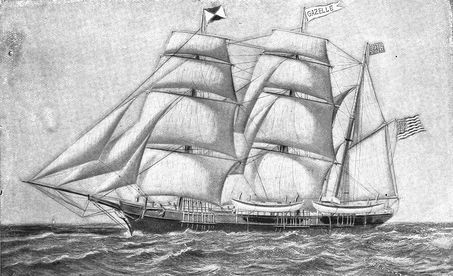 The Gazelle, the ship that rescued O'Reilly from Western Australia (Roche, James Jeffrey, John Boyle O'Reilly - His Life, Poems, and Speeches, 1891). The Gazelle, the ship that rescued O'Reilly from Western Australia (Roche, James Jeffrey, John Boyle O'Reilly - His Life, Poems, and Speeches, 1891). As John Boyle O'Reilly stood on the deck of the Gazelle that first day of his voyage in early March 1869 he was probably unaware that he had joined an American industry which, according to the historian Margaret S. Creighton, ‘represented seafaring at its extreme’. Voyages routinely lasted for up to four years and whaling ships spent much of their time sailing through the most dangerous seas in the world. The heart of this global industry lay in the American port of New Bedford, Massachusetts and, each year, hundreds of whaling ships sailed from the so-called ‘Whaling City’. In August 1866 the Gazelle had been one of these ships and had been over two years at sea by the time it picked up O’Reilly. Throughout the nineteenth century these American ships mostly hunted four types of whale; the sperm whale, often referred to as a cachalot, was hunted mostly in the warm tropical and sub-tropical waters of the Pacific, Indian, and Atlantic Oceans; the right whale, hunted in the more temperate regions of the world’s oceans; the bowhead whale, also called the Arctic whale, which was hunted in the cold waters of the Arctic circle; and the humpback whale which was hunted all over the world but most heavily in the Atlantic Ocean. The bodies of the whales caught and slain by the whaling ships provided a range of important products. From the sperm whale came sperm oil. That oil was traditionally burned in lamps, especially street lamps, and had been used to illuminate cities across Europe and the United States for much of the eighteenth and early nineteenth century. By the middle of the nineteenth century street-lamps were more often fired by gas but sperm oil remained in demand as a lighting fuel. Sperm oil was also used as machine lubricant. Other types of whale likewise furnished whale oil but these were heavier and of poorer quality than sperm oil and their oils were used more often as a lubricant rather than for illumination. The vagaries of fashion provided another ready market for whale products. A commercially important substance provided by Sperm whales was called spermaceti and was extracted from the animal’s head. The hunters would cut a large hole in a captured whale’s skull. One of the sailors would then crawl through this hole and manually remove the fluid. The spermaceti was placed in barrels for the rest of the voyage. This substance was used in the manufacture of candles and soaps. Sperm whales were also harvested for ambergris, an ash-coloured secretion found in the creature’s intestines. It was used as a fixative in perfumes. Other types of whales were killed for their baleen; a comb-like structure in the animal’s mouth which served to filter seawater for food. Baleen, also commonly known as whalebone, was light, strong, flexible and perfectly adapted to the manufacture of corsets, dress hoops, umbrellas, and other similar items. The most heavily hunted families of whales suffered grievous population losses from the eighteenth century onwards but they were to receive some respite in the second half of the nineteenth Century with the rise of kerosene as a competitor to whale oil. By 1858 the North American continent’s first oil well had been drilled at Oil Springs in Canada. During the following year the US petroleum industry began with the drilling of an oil well in 1859 at Oil Creek in Pennsylvania. The petroleum industry had a ready made market and over the following decades, as its production methods improved, the industry was able to massively increase the volume of petroleum produced. A further advantage for the petroleum industry was the fact that it could produce oil in the US whereas whaling firms had to purchase and equip ships which were then sent on hazardous multi-year voyages. As such, the owners of the oil wells were able to supply lighting oil at a far cheaper price than the whaling industry. Whalebone remained a commercially desirable product but it was whale oil that had been the mainstay of the industry. As the demand for whale oil steadily decreased, its price per barrel followed the same trajectory. Following these developments the whaling industry entered a precipitous decline during the 1860s and by 1869 only around 280 American whalers still plied their trade. These ships were crewed by approximately 8,000 men of whom O’Reilly was now one. On board the Gazelle were 31 crew; fourteen Americans, fourteen Portuguese, two Dutch and one Brazilian. Added to this mix was O'Reilly and the next few months were to prove to be a dangerous and transformative time for the young Irishman. Comments are closed.
|
Ian Kenneally
Short articles about the life and times of John Boyle O'Reilly. Archives
March 2020
Categories
All
|